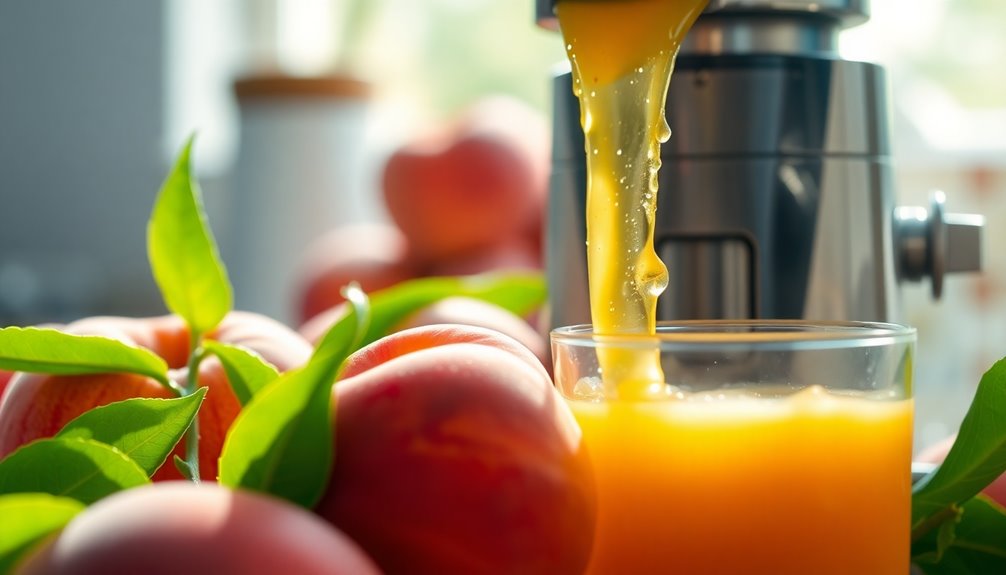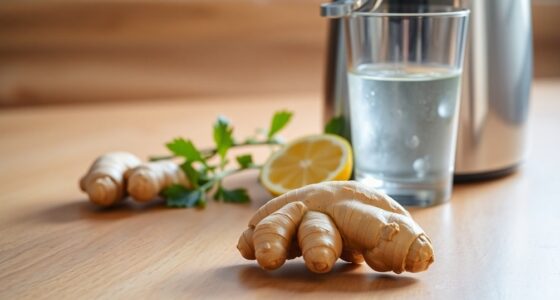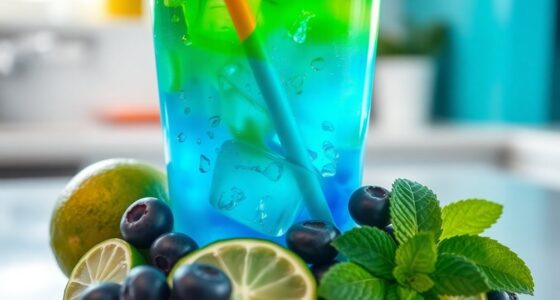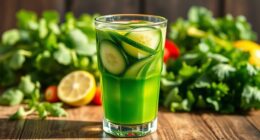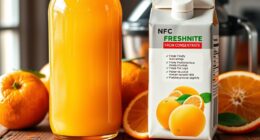To juice peaches, start by choosing ripe, fragrant peaches and washing them. Slice the peaches in half, remove the pits, and cut the halves into quarters. If using a juicer, feed them directly in; for a blender, add a splash of water and blend until smooth. Strain the mixture through a fine mesh strainer to collect the juice. You can enhance the flavor with sweeteners or lemon juice. There's much more you can explore with delicious peach juice!
Key Takeaways
- Select ripe, fragrant peaches and wash them thoroughly before juicing.
- Slice the peaches in half to remove the pits and cut them into quarters.
- Use a juicer to process the peach slices or blend them with a bit of water.
- Strain the blended mixture through a fine mesh strainer to separate juice from pulp.
- Enhance the juice with sweeteners or lemon juice for added flavor before serving.

Juicing peaches is a delightful way to enjoy their sweet, juicy flavor, especially when they're in season. When you've got ripe peaches at your fingertips, you'll want to take full advantage of their deliciousness. Start by selecting the perfect fruit; look for peaches that are plump and fragrant.
Once you've gathered your peaches, wash them thoroughly to remove any dirt or residue. The next step is to remove the pits. It's as simple as slicing the peaches in half and twisting them apart to release the pit. After that, slice the peach halves into quarters, making them easier to handle.
If you've got a juicer, you can simply feed those peach slices into the machine and watch as the juice flows out. However, if you prefer to juice with a blender, you'll need to take a different approach. Add your peach slices to the blender along with a small amount of water. This helps to create a smoother blend.
Blend until smooth, and then strain the mixture through a fine mesh strainer or a nut milk bag to separate the juice from the pulp. This method can yield a delightful fresh peach juice that's bursting with flavor.
To enhance your peach juice recipe, consider adding sweetener. A touch of honey or maple syrup can elevate the sweetness, making your juice even more enjoyable. You might also want to squeeze in a splash of lemon juice to balance the flavors. This combination will create a refreshing peach nectar that's perfect for hot summer days or as a base for cocktails and smoothies.
Once you've made your fresh peach juice, you'll need to think about storage. If you're planning to enjoy it within a couple of days, simply store it in an airtight container in the refrigerator. Fresh peach juice is best consumed within 1-2 days for optimal taste.
If you want to save some for later, consider freezing it. Pour your peach juice into ice cube trays and freeze for up to three months. This way, you'll have peach nectar on hand whenever you need it.
If you're using frozen peaches instead of fresh, make sure to allow them to thaw completely before juicing. This will ensure you get the best results. You may need to adjust the amount of added water based on the consistency you prefer. The key is to achieve a smooth, flavorful juice that captures the essence of ripe peaches.
Juicing peaches isn't only simple but also incredibly rewarding. Whether you're sipping on fresh peach juice or using it in your favorite recipes, you'll love the sunny, sweet taste of summer in every glass.
Frequently Asked Questions
Do You Have to Peel Peaches Before Juicing?
You don't have to peel peaches before juicing, but it depends on your preference.
Leaving the skin on adds fiber and nutrients, enhancing the juice's health benefits. If you're using non-organic peaches, it's better to peel them to avoid pesticide residues.
Remember, the skin can thicken the juice, so you might want to strain it for a smoother texture.
Choose ripe, in-season peaches for the best flavor, regardless of whether you peel them or not.
How to Make Peaches Juicier?
To make peaches juicier, choose ripe, in-season varieties that yield slightly to pressure.
Chill them overnight in the refrigerator for added refreshment.
If you want even more juice, blanch the peaches for about 30 seconds in boiling water to soften the flesh.
When blending, add a splash of cold water or coconut water to enhance the extraction process.
Avoid overripe or underripe peaches to ensure a flavorful, juicy result.
Are Peaches Good for Juicing?
Did you know that peaches can contain up to 90% water? That makes them fantastic for juicing!
You'll find their natural sweetness, with about 13-15 grams of sugar per 100 grams, eliminates the need for added sweeteners.
Plus, their rich vitamins A and C, along with antioxidants, boost your juice's nutritional value.
Whether you peel them or not, ripe peaches will give you a refreshing and delicious drink that's hard to resist!
Can You Steam Juice Peaches?
Yes, you can steam peaches before juicing them. Steaming softens the fruit, making it easier to extract juice, especially if you're working with firmer varieties.
Just place the peaches in a steamer basket over boiling water for about 5-10 minutes. After steaming, the skins come off easily, which helps create a smoother juice.
Plus, steaming can concentrate the natural sugars, giving you a sweeter juice without needing added sweeteners. Enjoy!
Conclusion
Juicing peaches is like capturing summer in a glass—sweet, refreshing, and bursting with flavor. As you savor each sip, you'll appreciate the contrast between the juicy, sun-kissed fruit and the cool, crisp liquid it becomes. It's a delightful reminder that something so simple can transform into pure joy. So, grab those ripe peaches and let their vibrant essence uplift your day. You've turned natural sweetness into a sip of sunshine—how amazing is that?
Cindy thoroughly researches juicing trends, techniques, and recipes to provide readers with practical advice and inspiration. Her writing style is accessible, engaging, and designed to make complex concepts easy to understand. Cindy’s dedication to promoting the advantages of juicing shines through her work, empowering readers to make positive changes in their lives through the simple act of juicing.

